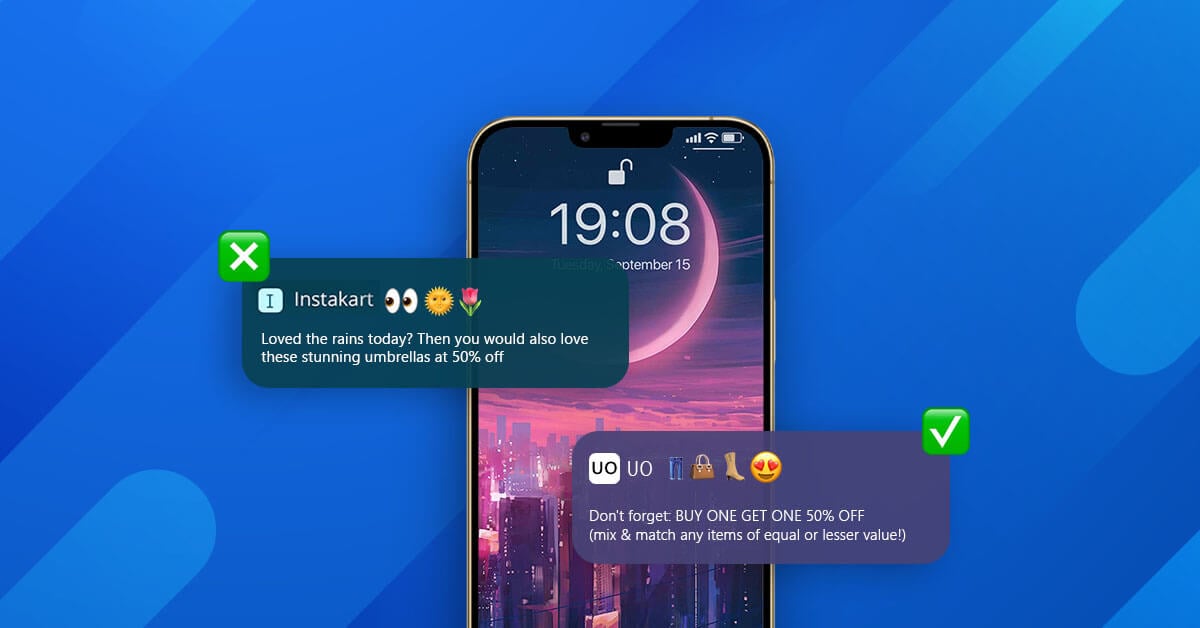Take a look at your smartphone right now. Do you see any emojis? Most likely in a text from a friend, colleague, or Facebook message. Emojis have become so popular that we have World Emoji Day and several other events to commemorate them.
Push notifications with emoticons to get an average of 25% more direct tap-throughs than mobile messages without a thumbs up, high five, dollar sign, or any other emoji you can imagine, according to E-Commerce Marketers.
Why use emojis, though?
Every app engagement is significant, with nearly 70% of customers obtaining relevant updates on their mobile devices. The Push is one of the most popular customer contact methods since consumers do not have to share information to stay up-to-date.
Besides, emojis are impersonal, strengthening the trust between the brand and the customer.
So what does this insight hold for you?
This blog will tell you about the dos, don’ts and best practices associated with using emojis in the push notification.
Fasten your seatbelt and read on!
The Rationale of Using Emojis in Your Push Notifications?
If you haven’t yet utilized emojis to enhance push notification interaction, here are five reasons why they might be effective for your e-commerce brand’s growth:
- Emojis uniquely personalize marketing. We, as customers, connect emojis with more personal communications, such as those we receive from friends and family. As a result, we may consider marketing messages to be similar.
- Emojis are well-known. Consumers are familiar with them since they have become the main component of our social interactions and routine life.
- Emojis may be used to enhance a brand. Dominos allowed customers to use a pizza slice 🍕 emoji to place an order, Baskin & Robbins used ice cream cone 🍦 emojis in their tweets, Dove created curly-haired emojis, and Twentieth Century Fox cleverly promoted a Deadpool movie with them.
- Emojis can teach your audience to have an immediate response by using certain emojis. When a person sees a specific emoji, it becomes a shortcut to a more significant concept. When individuals know that emoji in the earlier example, they might be trained to think about Dominos.
- Lastly, because they are graphics, emojis can convey information more quickly than words.
Dos of Using Emojis in Your Push Notifications
Drive Urgency
Is it easy or difficult to convey time-sensitive information? Make sure to advise clients that ⏰⏳it is running out and they must act quickly.
According to a recent study conducted by Sailthru, emojis with timers perform 20 percent better than other emojis. Staples, Target, Best Buy, and other major retailers employ this tactic more often in their campaigns than you’d think.
Choose Relevant Emojis Only
Do use the appropriate emoji for your audience. There are 2,823 emojis in the Unicode Standard, according to Emojipedia.org. Not all of those emojis will be suitable for your target audience, so pick carefully.
Emojis Must Have a Purpose
Use emojis for a reason. To make sure they’re visible, don’t just randomly sprinkle emojis throughout your push notifications. Make them count by using meaningful emojis.
Don’t Overuse Them!
Use them only when necessary. Some large businesses may get away with using a lot of emojis at once, but you’re better off utilizing just a few well-chosen emojis at first.
Make Sure the Context is Correct
Know your cultural surroundings when it comes to emojis. Clapping hands, for example, have a different connotation in the United States than in India. Even a basic smiling face emoji can appear differently depending on the device and software used, with some versions showing more like a scowl and resulting in misinterpretation of the message altogether.
Donts of Using Emojis in Your Push Campaigns
Avoid Inappropriate Emojis
Don’t use emojis unless they’re appropriate. Emojis might not be the best option for B2B marketing. E.g. funeral home service or any other serious B2B business where technicality and sentiment matter more than creativity.
Don’t Use Emojis for First-time Contacts
Don’t use emojis with someone new to your company right away. Because they are more personal and private, they’re best utilized with a client who already has familiarity with your business.
Don’t FOMO Over Emojis
Emojis should not be used merely because others are doing it. Do some testing. Make sure including emojis increases your participation rate.
Don’t Just Rely on Emojis for Messaging
Don’t assume that your meaning is obvious. When necessary, add words to clarify your message, especially when driving critical push campaigns to accelerate opt-ins.
In the End
What if you’re sure that emojis will improve your engagement but haven’t signed up with a push notification service yet?
With Wigzo, you can achieve the same and then some.
Try it FREE today to boost e-commerce sales and repeat purchases on complete automation.













